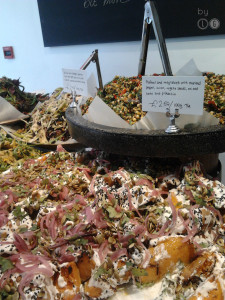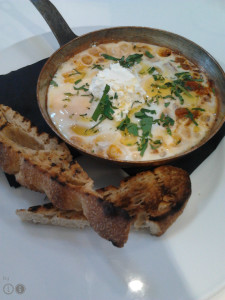About five years ago I had my first piece of food writing published in the magazine PresenTense, put out by the innovative Jewish organization of the same name. The piece was part of an issue that looked at the ways young Jews were exploring issues concerning food in a day and age very different from that of our bubbes’ and zaydes’. My article focuses on the increasing inclusion of Sephardic (or Mediterranean) flavors into the standard American Jewish diet, and it seems especially timely now that the whole world has been swept under the influence of Yotam Ottolenghi and Sami Tamimi’s amazing cookbook Jerusalem. I didn’t have a food blog back then, so I couldn’t easily share it with everyone, unlike today.
It was a fun trip back in time to find this piece, and I hope you enjoy reading it, and maybe even eating it. I’m including the full recipe for Moroccan Salmon since the creative photo doesn’t quite capture all the ingredients. We make this recipe with some frequency, since we usually have all the bits and pieces in the house. It’s bright, flavorful, and it makes a stellar dinner party centerpiece if you double the recipe for a side of salmon, cooked whole.
Moroccan Salmon* (adapted from Cooking Light)
This recipe is filled with Mediterranean flavors. It’s easy to prepare if you have a good kitchen knife or a small food processor. This is beautiful for a holiday dinner, but easy enough for a weeknight if you use shortcuts.
1/2 cup chopped fresh flat-leaf parsley or cilantro
1 Tablespoon olive oil
2 teaspoons fresh lemon juice
1/2 teaspoon salt
1/4 teaspoon ground ginger
1/4 teaspoon ground red pepper (cayenne works well)
1/4 teaspoon ground cumin
1/4 teaspoon freshly ground black pepper
4 garlic cloves, minced
4 (6-ounce) wild-caught salmon fillets (about 1-inch thick)
Cooking spray
1 lemon
3 cups thinly sliced red bell pepper (frozen mixed bell peppers will work well)
2 tablespoons water
1 large plum tomato, cut crosswise into 1/4-inch-thick slices (or 1 can diced tomatoes, drained)
*other firm-fleshed fish works well in this recipe—let your taste buds and budget be your guide
Preheat oven to 400°.
Combine first 10 ingredients in 13 x 9-inch baking dish. Do not use an aluminum pan—it will react with the acid in the dish. Add salmon, spreading paste thickly over the fillets. Cover and let stand 15 minutes while you prepare the other ingredients. Remove salmon from dish, reserving paste in a medium bowl (you may need to scrape it gently off the fish). Rinse the 13 x 9-inch dish and coat with cooking spray. Place the salmon, skin side down, in the dish.
Cut lemon in half lengthwise; cut each lemon half crosswise into 1/8-inch-thick slices. Add the lemon slices, bell pepper slices, 2 tablespoons water, and tomato slices to the spice paste; stir gently to coat. Arrange lemon mixture in an even layer over salmon; cover with foil. Bake at 400° for about 20 minutes or until fish flakes easily when tested with a fork or until desired degree of doneness.
Top each fillet with about 1/2 cup vegetable mixture, and drizzle each serving with pan juices.
For an easy weeknight pairing, make a quick pot of couscous and toss some toasted pine nuts, almonds and pistachios on top.

